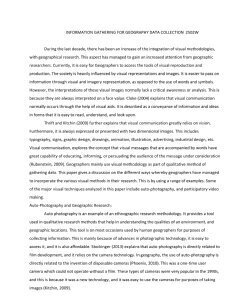INFORMATION GATHERING FOR GEOGRAPHY DATA COLLECTION During the last decade, there has been an increase of the integration of visual methodologies, with geographical research. This aspect has man 2502W
INFORMATION GATHERING FOR GEOGRAPHY DATA COLLECTION During the last decade, there has been an increase of the integration of visual methodologies, with geographical research. This aspect has man 2502W
INFORMATION GATHERING FOR GEOGRAPHY DATA COLLECTION 2502W
During the last decade, there has been an increase of the integration of visual methodologies, with geographical research. This aspect has managed to gain an increased attention from geographic researchers. Currently, it is easy for Geographers to access the tools of visual reproduction and production. The society is heavily influenced by visual representations and images. It is easier to pass on information through visual and imagery representation, as opposed to the use of words and symbols. However, the interpretations of these visual images normally lack a critical awareness or analysis. This is because they are always interpreted on a face value. Cloke (2004) explains that visual communication normally occurs through the help of visual aids. It is described as a conveyance of information and ideas in forms that it is easy to read, understand, and look upon.
Thrift and Kitchin (2009) further explains that visual communication greatly relies on vision. Furthermore, it is always expressed or presented with two dimensional images. This includes typography, signs, graphic design, drawings, animation, illustration, advertising, industrial design, etc. Visual communication, explores the concept that visual messages that are accompanied by words have great capability of educating, informing, or persuading the audience of the message under consideration (Rubenstein, 2009). Geographers mainly use visual methodology as part of qualitative method of
